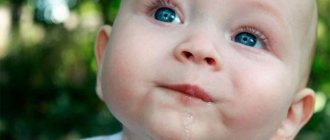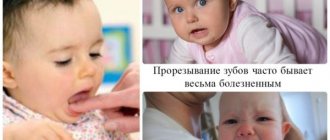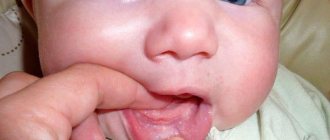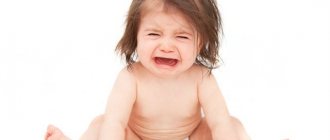How teeth are formed
The appearance of the first tooth is a milestone in a child's development. Now he's almost an adult! After all, his teeth will help him chew solid food and develop speech.
Baby teeth begin to form in the fetus as early as the 6th week of pregnancy. Between the 3rd and 6th months, enamel has already formed on the teeth. All this will be hidden under the gums for the time being. At the same time, deep in the jaw bone there are already the rudiments of molar teeth.
For most children, their first tooth appears between 4 and 7 months, but for some it happens later. With early development, it can erupt at 3 months or earlier. If the child grows normally and has no problems with skin and hair, then it’s okay. But if your baby is already 1.5 years old, and teeth have not appeared, you may need the help of a dentist.
The lower teeth usually appear about a month earlier than the upper teeth.
Approximate order of appearance of baby teeth:
- Lower central incisors (at 6 – 7 months).
- Upper central incisors (at 8 – 9 months).
- Upper lateral incisors (at 9–11 months).
- Lower lateral incisors (at 11 – 13 months).
- Upper small molars (molars) (at 12 – 15 months).
- Lower small molars (molars) (at 12 – 15 months).
- Upper canines (at 16 – 18 months).
- Lower canines (at 18 – 20 months).
- Lower large molars (molars) (at 24 – 30 months).
- Upper large (root) (at 23 – 30 months).
By age 3, your baby should have all 20 teeth, which will last until he is about 6 years old, when his first baby tooth falls out.
Don't be discouraged if your teeth grow crooked at first. Over time they will all fall into place.
Period of eruption of permanent teeth -
The eruption of permanent teeth has a number of features, because... This process occurs simultaneously with the resorption of roots and loss of baby teeth. The rudiments of permanent teeth are located only 1-2 mm from the roots of milk teeth, and when a permanent tooth begins to erupt, it puts pressure on the roots of the milk tooth located above it, which leads to their resorption. Accordingly, baby teeth gradually lose contact with bone tissue, and their crowns become mobile.
And only the eruption of molars (large lateral chewing teeth) occurs without the loss of milk teeth, which is associated with a smaller number of the latter. By the way, in girls, the loss of baby teeth, as well as the beginning of the eruption of permanent teeth, occurs 4-7 months earlier than in boys, which is associated with hormonal levels. You can see the sequence and timing of the eruption of permanent teeth in children in diagram No. 2, which clearly shows the time ranges for the start of eruption for each permanent tooth.
Permanent teeth in children: order of eruption
The first permanent teeth to erupt are the first molars, which usually occurs at 6 years of age. True, recently, teething increasingly begins at the age of 5, and this is associated with the acceleration of the physical development of children. The process of eruption of permanent teeth ends by the age of 14 (with the exception of wisdom teeth). Teeth are considered fully erupted only when their chewing surface begins to contact the antagonist teeth of the opposite jaw, and the gums cover the crowns of the teeth only in the area of their neck.
Moreover, please note that the sequence of eruption of permanent teeth on the lower jaw differs from the sequence of eruption of teeth of the same name on the upper jaw. For example, in the lower jaw, the first molars and central incisors erupt simultaneously, while in the upper jaw, the first molars appear earlier. Moreover, absolutely all teeth (with the exception of premolars) erupt earlier in the lower jaw.
Beginning of replacement of baby teeth with permanent teeth (6 years) –
How to understand that your baby is teething (symptoms)
Many people believe that the process of teething must necessarily be accompanied by general anxiety of the baby, fever and diarrhea. However, not all experts share this point of view. Some consider this a mere coincidence. There is an opinion that children, when they start teething, are more likely to put dirty objects in their mouths to scratch their gums, and cause an infection.
Some lucky people go through this period painlessly.
But most children still experience some discomfort:
- Anxiety;
- Increased salivation, which can lead to facial irritation;
- The gums swell and become more sensitive;
- Refusal to eat;
- Bad dream.
If your baby has a fever or diarrhea, consult a doctor.
What are the symptoms of teething
Only some parents do not encounter difficulties with their child’s teething and notice the incisor by chance, not understanding when it appeared. In most cases, the process is accompanied by unpleasant symptoms:
- Swelling, “looseness” of the gums. Redness and bumps may form. Sometimes the teeth show through the gums. In some cases, there are bluish hematomas.
- Increased salivation. This may cause rashes around the mouth. But salivation at 2 months of age does not always indicate teething. During this period, such a process is physiological. If the rashes appear in other places, this is not related to teething.
- Restless state. The child cries a lot, is capricious, and the quality of his sleep deteriorates. Often the baby cannot be calmed down. Conventional methods (swinging, pacifiers, etc.) do not help.
- Increased body temperature. More often these are indicators up to 37.5 ˚C. This can happen due to local inflammation (of the gums). A higher temperature indicates viral activity.
- Loss of appetite. During the period of teething, children eat poorly or refuse to eat at all. Sometimes the baby cannot be put to the breast. Some babies kick their legs and arch when feeding.
- Runny nose and cough. Due to increased salivation, mucus flows down the back of the throat. It gets into the nasal passages, since the baby at the age of two months is more in a lying position. When mucus enters the throat, it provokes a cough. More often it appears during sleep.
Such symptoms do not occur all at once and can be combined in different ways. They often become a serious cause for concern for parents. Even the fact that a child is teething at such an early age is already shocking to them.
It is important not to confuse the signs of infectious or neurological diseases that have similar symptoms with the process of teething. Therefore, it is better to show the baby to the doctor. The following symptoms are also reasons to seek help: the child is very lethargic, has a high temperature (above +38 C), vomiting or mouth ulcers. A child may also vomit due to excessive salivation when mucus enters the stomach. Loose and frequent stools also indicate an infection. Diarrhea can cause dehydration.
How to help your baby when teething
- Give your baby something to chew on, such as a teether, which can be pre-chilled in the refrigerator.
- Massage your baby's gums with a clean finger. You can first wrap your finger in clean gauze. This will relieve the pain for a while.
- If your baby is already eating solids, give him cool foods (applesauce or yogurt).
- You can give your child something hard to chew on, such as a cracker. Just make sure your baby doesn't choke.
- If all of the above does not help, you can give your child a baby pain reliever or a special teething gel - strictly after consulting a doctor.
Vomiting, runny nose and diarrhea are not always symptoms of teething. If your baby appears unwell, call the doctor.
Teething: how to help your baby
This may require a fair amount of patience. During such a difficult period, you should take the baby in your arms more often, caress him, distract him from unpleasant sensations with toys, turn on pleasant, soothing music, and you can sing if natural abilities allow. A walk in the fresh air can also have a calming effect. Children who are breastfed, during teething, begin to cry more often and ask for the breast, and a loving mother needs to be patient, putting the baby to the breast every time, even if he grabs the nipple areola harder than usual during feeding. To satisfy the child’s need to chew something and hold something in his mouth, you can naturally use special rubber rings or toys, so-called teethers. You can offer your child dry food or baby cookies.
Currently, pharmaceutical companies offer a wide range of different products, primarily in the form of gels to “soothe the gums.” In general, most of these products contain painkillers such as lidocaine. You should not abuse these funds. They are not completely harmless; the anesthetics they contain can have an adverse effect on the child’s nervous and cardiovascular systems, and most importantly, they can cause serious allergic symptoms and contribute to the exacerbation of atopic dermatitis (diathesis) in children prone to allergies. In connection with the above, I can recommend, to reduce swelling and inflammation of the gums during teething, such special dental anti-inflammatory drugs for topical use as Cholisal gel, which can be applied to the baby’s gums 2-3 times a day, but must be rubbed in (not too much). of course) with light massaging movements over the entire surface of the gums, and not just putting it in the child’s mouth.
In addition, you can give a child suffering from teething special homeopathic drops, for example Dantinorm baby, according to the instructions for the drug. In any case, if the disturbing symptoms described above in this article appear, I advise you to play it safe once again and call a pediatrician to the home of a child with a high fever. A professional should give his diagnosis and recommendations.
Choosing a toothpaste and brush
Has your baby cut his first tooth? Congratulations!
- Until one year of age, parents need to brush their baby’s teeth without toothpaste using a special silicone brush placed on their finger at least once a day.
- At one year old, the baby needs to pick up his first children's toothbrush - without toothpaste for now. It is better if the child chooses it himself. She should interest him, but not scare him away.
What should you pay attention to when choosing a children's toothbrush?
- Decor - kids love bright colors and funny characters.
- The handle should be comfortable, preferably made of non-slip material with a protective ring to avoid injury. Its length should correspond to the age of the child.
- It is important that the brush head is not too large and awkward. The optimal size is 2–3 teeth of a child. To avoid damaging your gums, it is better to choose a brush with a rounded head.
- Soft brushes with a bristle height of no more than 11 mm are suitable for children. It should be even so that the pressure on the surface of the teeth is uniform.
- From 2 to 2.5 years old, it’s time to start using toothpaste and teach your child to brush his teeth on his own. You need to choose a special baby toothpaste without fluoride, because the baby may want to eat it. You can switch to fluoride toothpaste when he learns not to swallow it.
How to brush your teeth correctly
- Your baby's teeth need to be brushed 2 times a day - in the morning and in the evening before bed.
- Use a small amount of toothpaste at first, about the size of a grain of rice, then work up to a pea-sized amount.
- If you use such a small amount of toothpaste, there is no need to rinse your mouth.
- Brush your teeth gently from the outside and inside.
- The tongue also needs to be cleaned, because bacteria accumulate on it, causing bad breath.
- Remember to change your toothbrush every 3 months.
At this stage, it is too early to floss because the teeth are usually far apart.
Creating a good habit
The habit of brushing your teeth should be established in childhood. If you don’t force your child, but figure out how to turn this activity into an interesting game, your baby will brush his teeth with pleasure. Here are some tips:
- Children love to copy adults, so lead by example by brushing your teeth with your child.
- If you brush your teeth with your baby, at the end open your mouth and show each other how you handled this “task.” If necessary, clean your child's teeth yourself.
- Don't scold him, no matter how badly he cleaned it. Children at this age have not yet developed fine motor skills, so do not expect precise movements from them.
- Let your child associate brushing his teeth with something joyful. Play his favorite children's music, tell him stories about teeth, and draw on a dental theme.
- Keep a piece of paper with a schedule for brushing your teeth. Divide the day into morning and evening (you can draw the sun and moon there) and check the box when you brush your teeth.
- Finally, talk to your child like an adult. Explain to him why brushing his teeth is good. Draw scary microbes on a piece of paper and together figure out how you can fight them.
If your little one refuses to brush his teeth, try buying him a new toothbrush with his favorite cartoon character on it. Get him interested. Get several toothbrushes and let him choose a new one each time.
What microelements are needed for teeth growth?
Fluorine
Fluoride strengthens tooth enamel, making it more resistant to acids and harmful bacteria. Thus, it helps prevent the development of caries.
Fluorine is found in:
- Toothpaste - however, remember that toothpaste with a small fluoride content can only be used by children over 4 years old;
- Fluoride-enriched water;
- Chewable tablets or drops;
- Some fruit juices.
Remember that too much fluoride can lead to fluorosis, which is when white spots appear on the teeth. Therefore, it is important not to use too much toothpaste, especially if the child has not yet learned to spit it out.
Calcium
Calcium takes an active part in the mineralization of teeth. A 3-year-old child should receive 800–1100 mg of calcium per day.
Products containing calcium:
- Milk, yogurt;
- Spinach and other green leafy vegetables;
- Broccoli;
- Fish.
In order for calcium to be better absorbed, it needs helpers. One is vitamin D and the other is vitamin K2.
Vitamin K
Calcium is collected and transported into bone tissue using the protein osteocalcin, which normally “dormants” peacefully in the blood. In order to activate it, you need natural vitamin K. It is found in dairy products (milk, yogurt, kefir, cottage cheese - for example, Agusha K2 cottage cheese).
Causes of delayed eruption of permanent teeth –
If for baby teeth delayed eruption is considered to be a delay of only 2-3 months, then for permanent teeth this figure is already 2-4 years. Among the main reasons for the delay in the eruption of permanent teeth, it is particularly worth highlighting the preceding inflammatory processes in the area of the roots of primary teeth, as well as the early removal of primary molars.
1) Violation of local conditions for teething:
- underdevelopment of the upper and lower jaws,
- lack of space in the dentition,
- premature removal of primary molars,
- incorrect position of the tooth germ,
- tooth germ injury,
- inflammation in the bone tissue of the jaws, for example, with purulent periodontitis of baby teeth.
2) Common causes of delayed eruption of permanent teeth:
- rickets or congenital syphilis,
- exudative diathesis,
- various chronic intoxications,
- metabolic disorders,
- disturbances of reflex-trophic processes,
- hormonal imbalances (for example, hypothyroidism, hypofunction of the thymus or adrenal glands).
Which permanent teeth are more likely to experience delayed eruption?
- one of the canines of the upper jaw (MF) – occurs in 43.64% of children,
- two HF fangs at once – in 25.65%,
- second premolar of the mandible (MF) – in 12.84%,
- two HF canines and LF second premolars at once – in 10.34%,
- both second premolars LF – in 5.11%,
- both lateral incisors HF – in 2.61%.
When should I take my child to the dentist?
The Ministry of Health of the Russian Federation recommends showing a child to the dentist once a year starting from 12 months.
The purpose of the first trip to the dentist is prevention. The doctor checks whether teeth are growing correctly and gives recommendations on oral hygiene. It is better to do this no later than your first birthday, so that the specialist does not miss caries and possible problems with your bite.
The first trip to the dentist should not frighten your child.
Here are some tips to make it painless:
- Do not pay too much attention to this event, do not prepare your child on purpose;
- Don’t worry yourself so that your baby doesn’t get nervous along with you;
- If possible, arrive early to your appointment to give your baby time to look around.











